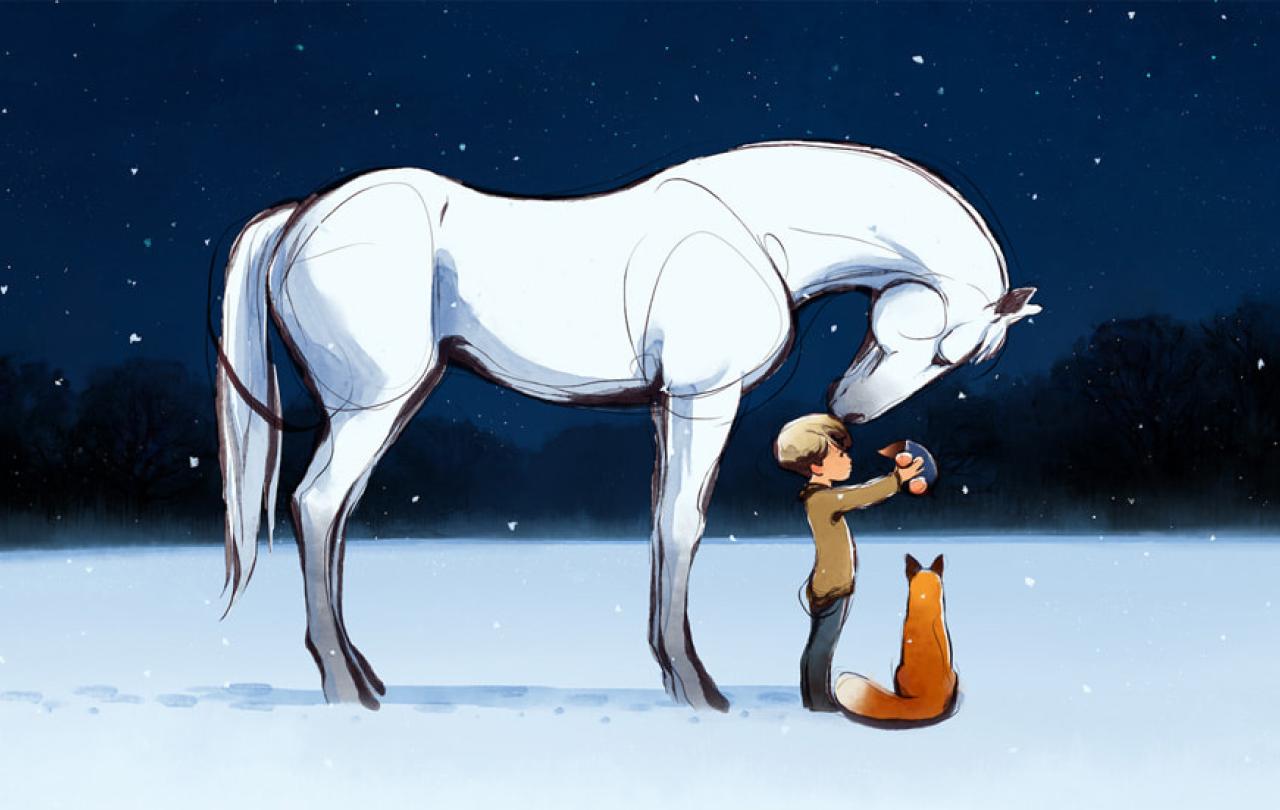
Four million of us dedicated half an hour of our Christmas Eve to watching Charlie Mackesy’s Academy Award-winning animated short film, The Boy the Mole, the Fox and the Horse, making it the most watched programme on that day. (Not to mention the five million of us who have streamed it since, making it the most watched film in its category at this year's Oscars).
More than two million of us have his illustrated book of the same name sitting somewhere in our homes, placing it firmly on both the New York Times and the Sunday Times best-sellers list.
Over one-and-a-half million of us have decided to make Charlie’s work a daily staple of our lives by following him on Instagram.
'Lives have been profoundly touched by the effect that Mackesy is having upon the world.'
And then, of course, there’s the impact of these lofty statistics, the depth of success that is running parallel to the breadth, the Mackesy Effect that can’t be quantified. I defy anyone to scroll through the online comments on his social media pages, browse the reviews of his book, or explore the Twitter hashtag pertaining to the short film, and not be struck by the stories of seemingly endless people whose lives have been profoundly touched by the effect that Mackesy is having upon the world.
My morning peek into the Twitter-verse shows that today alone, the animated film is being watched in schools as an exercise in mental and emotional well-being, copies of the book are being distributed to sufferers of PTSD and gifted to residents of care homes, while the distinctive drawings are adorning the walls of therapy rooms and hospital wards.
Fascination at such an impact can be reduced to a singular word: why?
This isn’t a question dubiously asked from a safe distance, surveying the astonishing success and scratching my head with scepticism. I am by no means unconvinced by the genius of it all. Quite the contrary, my copy of the book is one of the most well-thumbed books I own. I pull it off my shelf and open it up more regularly than I care to admit, each time utterly bewildered as to why it feels as though it was written just for that precise moment.
And so, to ask the question once more: what is it about this simple fable, in all of its various forms, that is continuing to captivate us? I have a theory. One that was somewhat hidden in plain sight all along.
There’s a phrase that has been whirring around my mind as I’ve been probing at Mackesy’s enchanting work: it is a fable in which children can paddle and elephants can swim. This phrase has been frequently used to describe a particular biblical book, the Gospel of John.
John’s Gospel has a reputation for being somewhat of a literary and theological enigma. Therefore, whether it be in pure delight or utter defeat, John’s Gospel has been described in this way – as a text in which children can paddle and elephants swim.
Far more than a whimsical-sounding review, this rather endearing visual very succinctly sums up the paradox that is the literary nature of the fourth Gospel. It can be read and understood at a surface level, each scene working together to create a tapestry of moments, curated to tell the tale of a life that caught the attention of everyone around it. And of course, a death and resurrection, painstakingly recorded to ensure that the impact of such a momentous life moves beyond the confines of first-hand witnesses. This is how the fourth Gospel has been paddled in for two millennia.
'This work is a text in which children can paddle and elephants can swim.'
But then there’s the ever-present invitation to swim with the elephants. In reality, this invitation is to sit and dissect every micro-detail, to delve into the intention undergirding every word choice, to pour over the precise placement of every narrative. It is an invitation to find meaning hidden within meaning hidden within yet more meaning, it is an invitation to surrender to the sheer genius of what John has produced and work out how to rightly respond to it.
And with this in mind, I return to the work of Charlie Mackesy. This is not to suggest that through The Boy, the Mole, the Fox and the Horse, Mackesy has created, or attempted to create, some kind of Biblical text. Surely, he, more than anyone, would positively balk at the idea. What I’m suggesting is that this work is a text in which children can paddle and elephants can swim.
The pages of the book, the scenes of the short-film, the images on the Instagram account - they can be consumed at a glance, they can be paddled in. The simplicity of them offers an antidote to our crowded lives, the whimsical nature of each character appeals to our desire for escapism, and the relatable nature of Charlie Mackesy himself (a self-proclaimed ‘grubby artist’) allows us to feel that his content is a safe place. And then there are the words that accompany each drawing he offers us; in the animated film, actors such as Idris Elba and Tom Hollander have been enlisted to bring the voices of the four beloved characters to life. In the book, Charlie’s own handwriting is tasked with doing all the talking. These messages, presented as brief conversations between the characters, are notably short in length and simplistic in nature, but let’s not allow that to fool us into assuming that they lack substance. On the contrary, there is sufficient depth to be swam in, and the invitation to do so is present on every page.
'What can be found by those who are wading away from the shores?'
And herein lies the theory: the invitation to paddle in the waters of this whimsical world may be what is attracting the world to Charlie’s work, but the opportunity to swim in its very applicable depths is what is keeping us captivated. Therefore, a question remains: what can be found by those who are wading away from the shores? I have a suggestion: re-enchantment of the most theological kind.
We’re living in an age of ‘disenchantment’ in the West, a societal state that was predicted by Max Weber in the early 20th Century, and profoundly resonates with our reality today. Weber used the term ‘disenchantment’ to denote a time when society will have discarded our reliance upon, and appreciation of, the mysterious, the spiritual, and the transcendent.
But are we satisfied with disenchantment?
Our apparent captivation with content such as Mackesy’s, which is intent on re-enchanting us, would imply not.
The longer you sit with Mackesy’s work (or swim in it, to keep a hold of the Johannine metaphor), the more apparent it becomes that neither the boy, the mole, the fox, nor the horse are actually the central characters. Rather, the things that hold the entire body of work together are the exact things that disenchantment refutes: the mysterious, the spiritual, the transcendent. Things that, to quote the book itself, ‘sit beyond all things’. Perhaps our appreciation of such things has not been disregarded, but profoundly underestimated. It could be suggested that our reliance upon such things is more intrinsic than we ourselves acknowledge, and every now and again, something as unlikely as a talking mole makes a profound mark on culture and subsequently proves it.
Charlie Mackesy has ultimately provided us with an invitation into re-enchantment.
'He wanted to reach out to a loved one in distress, but words kept falling short.'
The thing to note about re-enchantment is that it is, by its very nature, a return to something familiar; a previous perspective or an ancient wisdom perhaps. The vehicle is intriguingly new, but the cargo feels ancient. Or to be more specific, the cargo feels biblical.
Mackesy’s relationship with his Christian faith is paradoxically complex and enviably simple. He’s spoken many a time about the way he both perceives and receives the divine love that is at the core of the Christian faith. He has also given us a glimpse into how it tends to fuel his work. In an interview with CBN, Charlie tells the story behind one of his more explicitly biblical pieces of art entitled 'The Prodigal Daughter' . He spoke about how he wanted to reach out to a loved one in distress, but words kept falling short, so he painted her a picture. He said ‘I was just trying to show her through imagery where, you know, to be held is something she always wanted. So, I said, “This is what God is like”’.
Whether or not he has the same intention when it comes to his more commercial work, as you flick through each page of his best-selling book, that is exactly what you sense the characters within the book, and the man behind it, to be saying: this is what God is like.
Whether it be the horse, who is ‘the biggest thing they have encountered’ and takes it upon himself to carry the other characters physically and emotionally through the wilderness. Or the constant re-iteration that love is the means and the end to all things. Or even the narrative detail of each character becoming known, deeply, and honestly known, on levels that they had yet to experience. You could write ten books of theology or philosophy in an attempt to expound each theme.
And I, for one, hope it’s a place where children continue to paddle, and elephants continue to swim for a long time to come.





